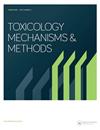氟氯酮处理大鼠睾丸RNA-seq分析
IF 2.8
4区 医学
Q2 TOXICOLOGY
引用次数: 3
摘要
摘要氟氯酮是一种在发展中国家广泛使用的除草剂。尽管睾丸是大鼠FLC的靶器官,但FLC对睾丸的不良影响尚未完全阐明。为了阐明它们,我们使用先前亚慢性毒性试验中FLC处理的大鼠睾丸进行了RNA-seq分析。溶剂对照组和三个FLC处理组的三只雄性大鼠的单侧睾丸(3 mg/kg,31.25 mg/kg和125 mg/kg)用于RNA提取。使用poly A选择方案与Illumina TruSeq RNA-Seq文库方案偶联来构建RNA-Seq文库。使用R.gene Ontology(GO)术语富集分析和Kyoto Encyclopedia of Genes and Genomes(KEGG)通路富集分析进行主成分分析(PCA)、差异表达基因(DEG)分析和层次聚类分析(HCA),可视化和集成发现(DAVID)。结果表明,许多上调的DEG在与睾丸损伤相关的途径中富集,如丝裂原活化蛋白激酶(MAPK)信号传导、溶酶体和局灶性粘附。许多下调的DEG在与睾丸生殖功能相关的途径中富集,如性生殖、精子发生和生殖细胞发育。此外,我们确认口服无不良反应水平(NOAEL)为 mg/kg的亚慢性毒性试验,因为3 mg/kg FLC处理组与溶剂对照组相似。31.25 mg/kg和125 mg/kg组,DEG显示睾丸损伤与氧化应激有关。本文章由计算机程序翻译,如有差异,请以英文原文为准。
RNA-seq analysis of testes from flurochloridone-treated rats
Abstract Flurochloridone (FLC) is a widely used herbicide in developing countries. Although the testes are a target organ for FLC in rats, the adverse effects of FLC on testes have not been fully elucidated. To clarify them, we performed RNA-seq analysis using the testes of FLC-treated rats from our previous subchronic toxicity tests. Unilateral testes of three male rats from solvent control groupand three FLC-treated groups (3 mg/kg, 31.25 mg/kg and 125 mg/kg) were used for RNA extraction. A poly A selection protocol coupled with an Illumina TruSeq RNA-Seq library protocol was used to construct RNA-Seq libraries. Principal component analysis (PCA), differentially expressed gene (DEG) analysis, and hierarchical clustering analysis (HCA) were conducted using R. Gene Ontology (GO) term enrichment analysis and Kyoto Encyclopedia of Genes and Genomes (KEGG) pathway enrichment analysis were performed to understand the biological characteristics of the DEGs using the Database for Annotation, Visualization and Integrated Discovery (DAVID). The results indicated that many up-regulated DEGs were enriched in pathways associated with testicular injury, such as mitogen-activated protein kinase (MAPK) signaling, lysosome and focal adhesion. Many down-regulated DEGs were enriched in pathways associated with testicular reproduction function, such as sexual reproduction, spermatogenesis and germ cell development. Moreover, we confirmed the oral no-observed-adverse-effect level (NOAEL) of 3 mg/kg in subchronic toxicity test, because the overall testicular gene expression in 3 mg/kg FLC-treated group was similar to that of the solvent control group. In 31.25 mg/kg and 125 mg/kg groups, DEGs revealed that testicular injury was related to oxidative stress.
求助全文
通过发布文献求助,成功后即可免费获取论文全文。
去求助
来源期刊

Toxicology Mechanisms and Methods
TOXICOLOGY-
自引率
3.10%
发文量
66
期刊介绍:
Toxicology Mechanisms and Methods is a peer-reviewed journal whose aim is twofold. Firstly, the journal contains original research on subjects dealing with the mechanisms by which foreign chemicals cause toxic tissue injury. Chemical substances of interest include industrial compounds, environmental pollutants, hazardous wastes, drugs, pesticides, and chemical warfare agents. The scope of the journal spans from molecular and cellular mechanisms of action to the consideration of mechanistic evidence in establishing regulatory policy.
Secondly, the journal addresses aspects of the development, validation, and application of new and existing laboratory methods, techniques, and equipment. A variety of research methods are discussed, including:
In vivo studies with standard and alternative species
In vitro studies and alternative methodologies
Molecular, biochemical, and cellular techniques
Pharmacokinetics and pharmacodynamics
Mathematical modeling and computer programs
Forensic analyses
Risk assessment
Data collection and analysis.
 求助内容:
求助内容: 应助结果提醒方式:
应助结果提醒方式:


